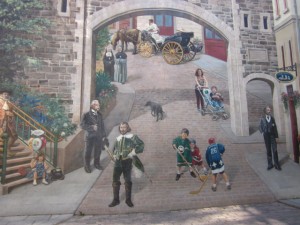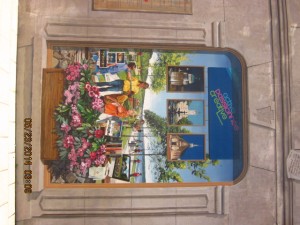Nikki Cotton
ASC 2798.04
Dr. Cabral
June 2, 2014
Inhale Yoga, Exhale Therapy: Therapeutic Use of Yoga in Canada vs. United States
While yoga has become vastly popular in the western world, yoga therapy is an emerging field. The International Association of Yoga therapists defines yoga therapy as “the process of empowering individuals to progress toward improved health and well-being through the application of the philosophy and practice of Yoga.” (Taylor 1) Yoga therapy is defined by Dr. Richard Miller as “the application of Yogic principles to a particular person with the objective of achieving a particular spiritual, psychological or physiological goal.” (Miller 1) Dr. Miller explains the three perspectives that yoga therapy is applied from in his article Yoga Therapy: Definition, Perspective, and Principles.
1. The use of Yoga to gain a sense of power, i.e., to develop muscular power, the power to concentrate, the power to do difficult postures, the ability to work over an extended period of time, etc. This is called the application of shakti-krama.
This form of yoga would be used well as therapy for PTSD, anxiety, OCD, ADD, ADHD, sexual assault, addiction, eating disorders, depression, abuse and other traumas.
2. The use of Yoga to heal specific problems, such as eliminating impurities in the organs (doshas) or energy centers (cakras) and channels (nâdîs) of the body. This is chikitsâ-krama.
- If sickness is present, it needs to be cured (chikitsâ).
- If sickness is not present, protection is necessary (rakshana).
- If sickness is not present and one has learned how to protect oneself, training is necessary (shikshana).
This application of yoga would be used for back pain, sleeping disorders, stress, physical illnesses, detox, cancer and overall health.
3. The use of Yoga to go beyond the physical to understand what is beyond the limited sense of self; to know one’s true self as unchanging Witnessing Presence (Purusha) of all that is changing (prakriti). This is called the application of âdhyâtmika-krama.
Dr. Miller also explains the principles behind the application of âdhyâtmika-krama.
Teach what is appropriate to the individual (yukta-shiksana).Differences in different people must be respected (bheda).Teachings must consider the situation, place, or country from which the student comes (desha). Each person needs to be taught according to his or her individual constitution, age, disposition, etc.(i.e., obese, lean, young, old, etc.) (deha).The method of instruction depends on the time of year, the seasons, etc. (kâla). Depending on the occupation of the student, he or she will need to be taught different things (e.g., a runner would be taught differently than a philosopher) (vritti).One must understand the capacity of the student, how much endurance he or she has, how much memory, how much time to study or practice (shakti).The teaching must conform to the direction of the mind (i.e., it must take a person’s interests into account, such as exercise, devotion, God, chanting, etc.) (mârga). This application is appropriate for overall well-being. (Miller 1)
To obtain understanding of Canadian’s view of yoga therapy, Dr. Stéphane Bensoussan filled as a reference. Dr. Stéphane Bensoussan is a holistic health and educational psychologist, Director of Clinique Psy-Santé, author and an inspirational speaker. Dr. Bensoussan has a bachelor degree in psychology from McGill University, a master degree in Educational Psychology and Counseling from McGill University, studied behavioral cognitive therapy and behavioral medicine at Montreal General Hospital, child development and parenthood training, psycho-oncology, psychoneuroimmunology from the National Institute of Clinical Applications of Behavioral Medicine, spiritual psychotherapy, mindfulness mediation, natural health and a yoga therapy license and clinical applications. Dr. Bensoussan uses a variety of therapeutic tools including cognitive behavioral therapy, hypothesis, play therapy, drama therapy, inner child, imagery and therapeutic use of yoga.
Dr. Bensoussan has been practicing yoga for 22 years and enjoys it very much. He has been using yoga therapy for eight years. He has seen improvement in his work becoming more and more refined. He has also become better at selecting postures for different programs and clients. As a young psychologist, he was trained to use cognitive behavioral therapy and other talk therapy tools. While he enjoyed it, he also realized that these widely used therapy tools have limits. Clients going through difficult times come to therapy searching for answers to questions. He noticed that many clients had more questions than answers at the end of therapy sessions. Talking too much about traumas or unwanted emotions fires up neurons in the brain creating more negative mind space.
While re-evaluating his methods of therapy, Dr. Bensoussan realized how much psychology is in yoga. He started using Buddhist principles and mindfulness techniques. Dr. Bensoussan stated that emotional suffering is because the mind is busy so it thinks of painful things. His number one rule as a psychologist is to release emotional suffering. When it is capable, he believes that bringing someone to their inner self through yoga, meditation and other mindfulness techniques will give them more self-power. Yoga also influences the brain’s fat.
During mediation and movement, the mind is very focused. Energy and breathe goes through the muscles, body and back to the mind. By keeping the mind busy, it is unable to make new neurons about traumas or other difficult emotions. Yoga also teaches an important lesson of feeling pain, then working through it and finally letting it go. During each pose, there is a level of discomfort while the muscles are stretching, retracting, lifting and holding balance. A client practicing must first accept the presence of discomfort, work through it by deep breathing and then let go of the pose. Yoga allows the patient to connect what is going on in their body and let go of the story going through their mind. For traumas, it helps them find empowerment and let go of the role of the victim. By not giving a lot of emotion to the event it does not create too much mind space for the event. It will also make them feel like they are accomplishing something during therapy sessions. Talk therapy often has the reverse effect. Dr. Bensoussan realized that yoga was working better than other techniques.
Dr. Bensoussan uses yoga therapy for many populations. He uses it with clients with ADD or ADHD. Leading them through a series of poses helps focus the mind. He uses yoga on kids who like to play and be busy. It takes away rituals for people with OCD. It takes them out of their mind and focuses on their body. He also uses it with clients with anxiety, depression, trauma and eating disorders. For eating disorders, yoga allows patients the experience of loving their body through a stretch and release tension. It is a victory for them. They learn to re-appreciate muscles and their body.
Dr. Bensoussan explained his knowledge of the view of yoga therapy in Canadian’s healthcare system. Yoga therapy is not recognized and not widely known in Canada. It is viewed by most as a sport. Although it is recognized by the complimentary therapy world, it is not covered by insurance. Clients who benefit from therapeutic use of yoga must pay out of pocket for the private service. The decision whether or not to include therapy sessions under insurance is made by Health Canada. Each providence has their own organization. Doctors will recommend yoga for stress, anxiety, back pain or sleeping problems. They rarely recommend yoga therapy since many do not understand the difference between them. Psychologists also view yoga therapy in the same way. Psychologists are trained in a variety of ways so there is a great lack of awareness. Dr. Bensoussan stated that yoga therapy has only started to become known in the past three years. He predicts that it will become mainstream in Canada in the next ten years or so.
Canadian and United States healthcare has similar views of therapeutic use of yoga as of present. It is not recognized by healthcare or covered by insurance in either country. It has not been well defined in either the United States or Canada. Complementary and Alternative Medicine (CAM) claims that for yoga therapy to be covered in the United States it would have to include a definition, a scope of practice, standards of training and organized representation. Insurance for yoga in the United States is controversial. Many CAM therapists do not wish to be compromised into the current health system. Dr.Stéphane Bensoussan stated in his interview that he would like to see the two worlds bridge and work with physicians. He does not, however, represent all of Canada’s current yoga therapist.
Dr. Rao, Dr. Varambally and Dr. Gangadhar, psychiatrists from Toronto, Canada, explain that the present method for classifying physical and mental illness is based on allopathic understanding of body-mind dualism. Yoga is based on body-mind interaction. Therefore, yoga practitioners must find a way to diagnose disorders more closely to the body-mind dualism. Compromising between both systems of medical and yoga practitioners proves to be difficult. (Rao 148)
A difference between yoga therapy in the United States and Canada is the standards for being a yoga therapists. Dr. Bensoussan has a psychology degree and yoga therapy license. The standards in the United States for a yoga therapist is as of the following: well-trained yoga teacher (meets Yoga Alliance standards at the 500-hour level), well-experienced yoga teacher (four years and 1000 hours teaching experience) along with additional training (300-500 hours) including therapeutic applications, biomedical sciences and practicum or externship. (Kepner 98) The United States is progressing ahead in making standards for yoga therapists as a whole. The Canadian Yoga Alliance is concerned about making paper standards for their teachers stating; “It takes years to develop and refine ones understanding of true transformation, as well as learning and mastering the vital breaths. If an instructor is not proficient in the breath (pranayama) and understanding of the ecology (of the body) and economy (of the energy) of the body, than it is not True Yoga that is being taught.” (Canadian Yoga Alliance)
Another difference between the two countries is the difference between the two countries are the organizations supporting yoga therapy. In Canada, there is the Canadian Yoga Alliance which supports anyone who practices yoga. Both countries have members in the International Association of Yoga Therapists. The United States, however, has a more active role in publish articles for the association. In the U.S., there are also many up and coming foundations that support the therapeutic use of yoga. The Give Back Yoga Foundation gives out grants to individual/organizations who use yoga to help heal underserved groups and inspire communities. Grants have helped veterans, prisoners, kids with cancer, Women and Children centers, low income families, pregnant women, addiction centers and mental disabilities across the country. Eat Breathe Thrive is a program created by Chelsea Roff to helped survivors of eating disorders. This program has been taught to yoga and eating disorder centers from coast to coast. The Joyful Heart Foundation was founded by Mariska Hargitay who was inspired by her role in Law and Order: Special Victim Unit. This organization takes a holistic approach to help healing those who have survive sexual assault, domestic abuse and child abuse. They also have a program to help the healers and anyone else affected by helping the survivors. Yoga and meditation is part of The Joyful Heart Foundation’s retreats. In Canada, single psychologists and yoga experts have programs to benefit certain populations such as Dr. Bensoussan.
Yoga therapy is a new, growing field in both Canada and the United States with progress being established in different ways. Both countries lack awareness of the difference between yoga and yoga therapy in the medical world. It lacks standards in both countries to allow it to be covered by health insurance. The United States is starting to form standards and organizations in support. Canada is focusing on coming up with a way to comprise the body-mind dualism and body-mind interaction to allow medical practitioners and yoga practitioners to work together. Yoga therapy will most likely be established in the United States first with Canada following behind within the next decade.
Work Cited
Bensoussan, Stéphane, Dr. “Yoga Therapy.” Telephone interview. 20 May 2014.
Interview
Kepner, John. “Alternative Billing Codes and Yoga: Practical Issues and Strategic Considerations for Determining “What Is Yoga Therapy?” and “Who Is a Yoga Therapist?”” International Journal of Yoga Therapy 13 (2003): 93-99. Web. Journal Article.
Miller, Richard, Dr. “Yoga Therapy: Definition, Perspective and Principles.” International Journal of Yoga Therapy (n.d.): 1-2. Web. Journal Article.
Rao NP, Varambally S, Gangadhar BN. Yoga School of thought and psychiatry: Therapeutic potential. Indian J Psychiatry 2013;55:145-9.
Taylor, Matthew J., Dr. “What Is Yoga Therapy? An IAYT Defintion.” International Journal of Yoga Therapy (2007): 1. Web. Journal Article.
“Welcome to Canadian Yoga Alliance.” Welcome to Canadian Yoga Alliance. N.p., n.d. Web. 02 June 2014.


 They are named after Obama because on February 19, 2009 he bought some cookies from the Bywater Market for his daughters. Canada was one of the first countries he visited. When Obama visited Berlin, they painted a huge mural to celebrate his arrival. Canada was offended after helping out the United States post 9/11. President Bush stated there was no reason to thank them because thanking family is not necessary. While in Berlin, the class found graffiti on a walking tour that said “F*** Bush. This makes a statement on how different leaders really do affect the worldwide view of the United States.
They are named after Obama because on February 19, 2009 he bought some cookies from the Bywater Market for his daughters. Canada was one of the first countries he visited. When Obama visited Berlin, they painted a huge mural to celebrate his arrival. Canada was offended after helping out the United States post 9/11. President Bush stated there was no reason to thank them because thanking family is not necessary. While in Berlin, the class found graffiti on a walking tour that said “F*** Bush. This makes a statement on how different leaders really do affect the worldwide view of the United States. 








 Berlin grafitti
Berlin grafitti 




 (http://frenchcanadianrightssovereignty.weebly.com/objective-conditions.html)
(http://frenchcanadianrightssovereignty.weebly.com/objective-conditions.html)

















